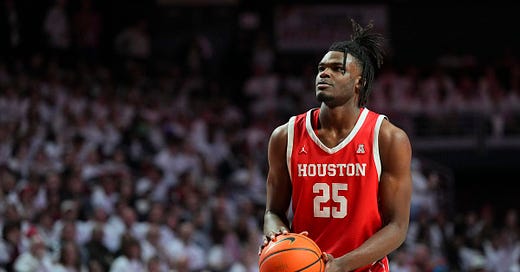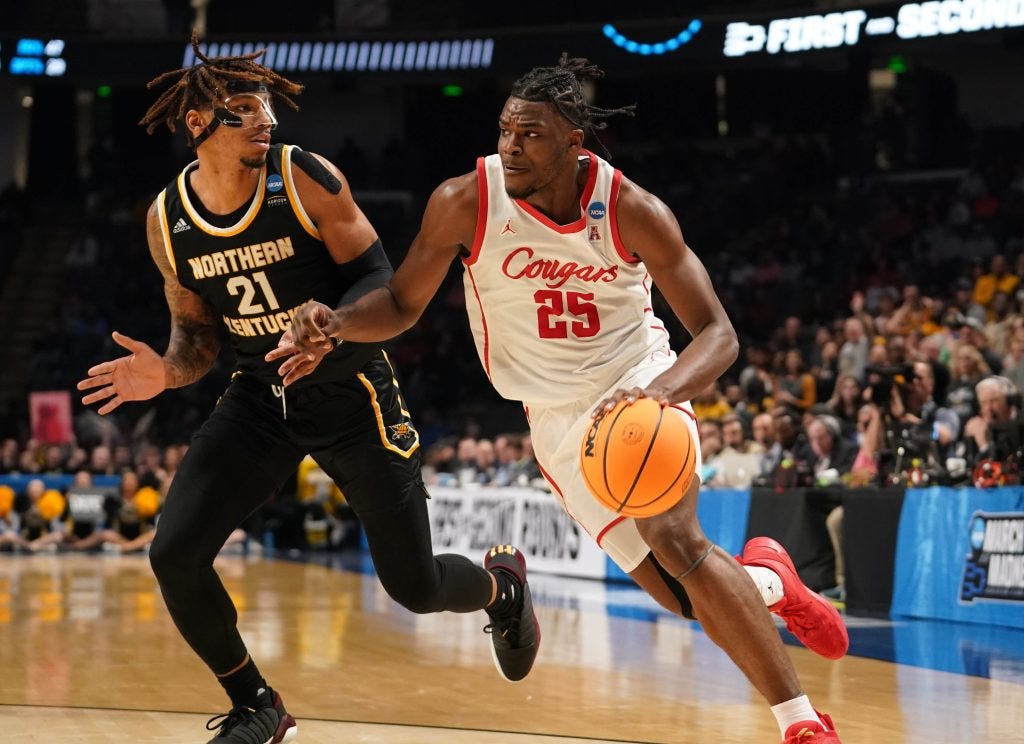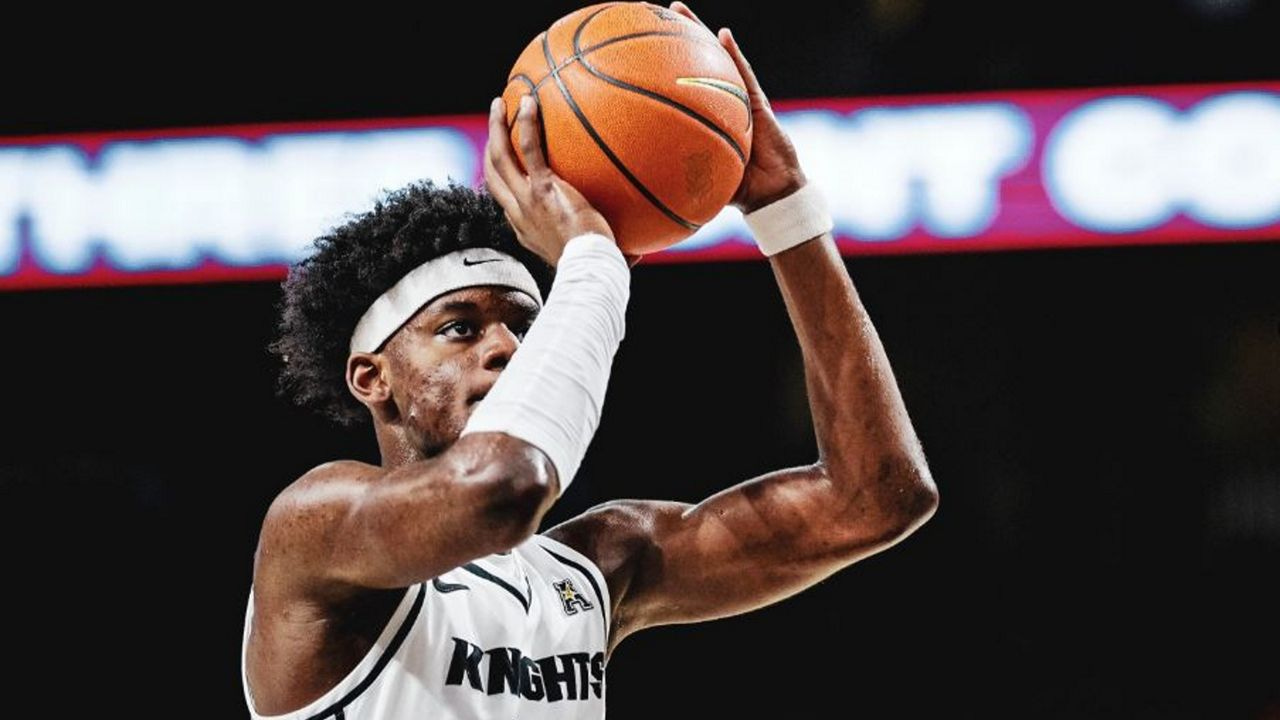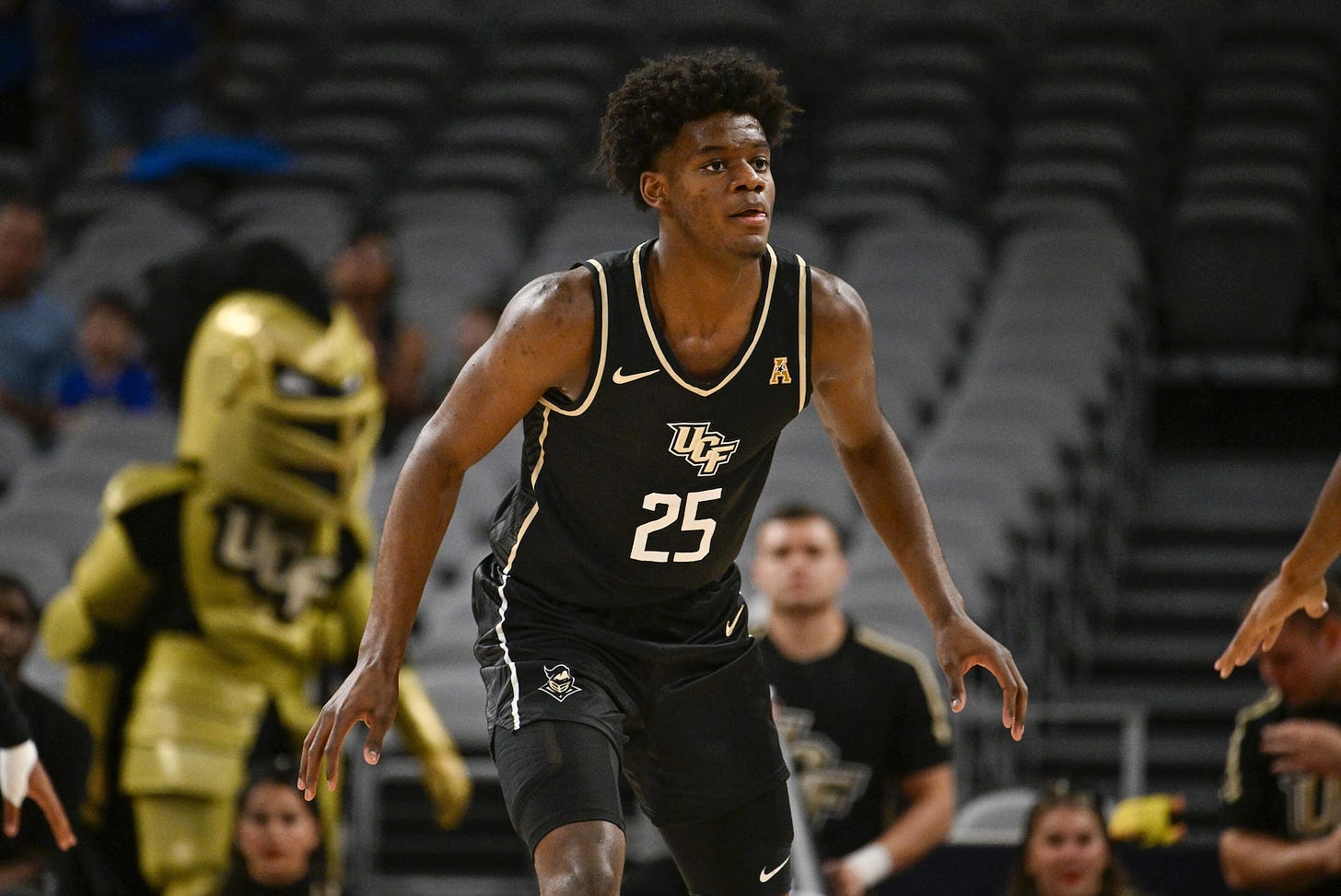Forward Thinking: Taylor Hendricks vs. Jarace Walker Film Breakdown (DraftPunk)
Two of the top forwards in the '23 Draft have been often compared. So who's better?
• • • • •
Many dubbed last season “The Year of the Big” in college basketball, and by many accounts, they’d be right. So many star forwards and centers took over the NCAA ranks, players like Hunter Dickinson, Oscar Tshiebwe, Drew Timme. Adama Sanogo was the MOP of the NCAA Tournament for the National Champion UConn Huskies, and the hottest commodities in the transfer portal this year were seemingly mostly bigs (Hunter Dickinson, Kadin Shedrick, Grant Nelson, Kel’El Ware, etc).
What I can tell you about this draft class is that it, outside of Wembanyama, is not “The Year of the Big.” Very few centers exist in this group, so the best big men prospects are mostly forwards. While there aren’t a ton of prospects at the 4, the two best in my mind are easily Houston’s Jarace Walker and Central Florida’s Taylor Hendricks.
And while they play the same position, they couldn’t be more different.
• • • • •
Jarace Walker, Houston (19.7 years)
This past season, Jarace Walker averaged 11.2 points, 6.8 rebounds, and 1.8 assists per game as well as one steal and 1.3 blocks on the defensive end. He shot 46.5% from the field and 34.7% from three, while posting a 66.3% average from the free-throw line.
While I wouldn’t say he’s an excellent offensive player yet, he’s got more of a bag than people give him credit for, and his three-point shooting isn’t bad. He’s got a solid handle for a forward, and can attack the rim sometimes, but is typically better when being set up, versus creating his own shot.
He can play the dunker spot despite being fairly undersized from a height perspective, standing at 6’6.5 (NBA bigs are generally 6’9+). Still, he’s a good finisher at the rim at 66.7%, and he has a few moves he can rely on occasionally when posting up. He’s a fantastic athlete, which helps these rim numbers and gives him versatility on the offensive end.
Here’s a look at that athleticism really quick on the alley-oop. He really gets up there –as a guy that weighs 250 pounds, he’s got a ton of bounce. He’s an above-the-rim finisher at the four-spot, which is pretty enticing if you’re an NBA scout.
He’s not just a “dunker” though – Walker has a burgeoning offensive skillset. Watch below how he forces the turnover by swatting the ball out of the Texas Southern guard’s hand, puts the ball on the deck down court, and finishes with a beautiful EuroStep. A 250-pound guy being that nimble and skilled is special – it’s a demonstration of his impressive athleticism, which means more than just a vertical leap. For a forward, he has excellent body control.
Here’s another clip of Jarace Walker displaying his offensive repertoire. He breaks down his defender off the dribble, fakes to his left, spins right, and hits the gorgeous turnaround jumper. This is the kind of thing people aren’t aware of with Jarace Walker – he can hit from the midrange within 17 feet (though not typically off the dribble, as he did here). On the year, he averaged 0.80 points per shot from 0 to 17 feet, putting him in the 59th percentile, which Synergy qualifies as “Good.”
In the following clip, Walker displays some post moves when he’s fed on the block. Though he shies way from contact (which we’ll get to), he has enough finesse to spin by the defender and score anyway.
Though he only averaged 1.8 assists on the year, Walker has demonstrated some pretty advanced playmaking. He is an excellent short-roll passer, which is an incredibly valuable skill in the NBA, where pick ‘n’ roll defenses are often aggressive.
Watch him hit this short-roll pass below to the open three-point shooter. As Virginia is in the pack-line defense, they are playing the roll man super tightly. Walker sees an opening on the perimeter, and slings it out on the run for a beautiful assist. The weakness of the UVA defense is skip passes to the weak-side for threes as well as drive-and-kicks. The short-roll pass functions as a drive-and-kick here essentially, leading to the wide-open three.
Your boy loves the short-roll pass, what can I say? In the clip below, he’s doing the same, this time with almost a ghost screen. Either way, it’s effective enough for Walker to catch the ball cleanly before dumping off the ball into the post, where the big finishes through contact and draws the foul.
Here is a fun clip. Watch Walker handle the ball before throwing an effortless behind-the-back bounce pass to Marcus Sasser, who drills the triple. The awareness Walker shows in plays like these indicate to me that he will be a solid distributor from the forward spot, as there is a natural feel for the game evident.
I love the playmaking potential for Jarace Walker at the next level. His passing out of the post is good as well, which will be the key for him when he’s playing on the block. Facilitation from a forward is really valuable.
However, where Walker really shines is his ability on the defensive end. What he lacks in height at his position he makes up for in fantastic positioning. Watch him track the ball handler all the way from the perimeter into the paint before perfectly timing his jump and stuffing the East Carolina guard. Houston also recovers the ball after the block, which is a seemingly underrated part of blocking a shot.
I think the clip below is important because it’s in a tie game with five minutes left, a.k.a. “Crunch Time.” Watch how Walker isn’t playing panicked in a close game like many freshmen would.
What shows his defensive maturity is the fact that he actually bites on the fake at first, but immediately gets back into defensive positioning instead of lazily trying to block the ball from behind. He stays with the Wichita State guard, and has the presence of mind to realize the Shockers are down to four seconds left on the shot clock.
Again, he times his leap perfectly, blocking the shot and forcing a shot-clock violation. It was a massive defensive play in an important moment by a true freshman, illustrative of his ability to step up in big moments.
Below, you’ll see a pretty recognizable player getting stuffed like a Thanksgiving turkey by Walker – it’s Brandon Miller of Alabama, a projected top-three pick. Miller makes a great dribble move to cross over the Houston defender before making his move to the cup. Enter Jarace Walker, who stays home on the drive instead of rushing out to contest; this turns out to be the right move, as he raises up and hits Miller with a huge rejection. Understandably, the crowd goes wild.
Overall, Jarace Walker projects as a day-1 starter for whichever team drafts him (which will almost undoubtedly be in the top six). He plays great defense, he rebounds, he has a developing offensive skillset, his three-point shot is coming along, and he is great at forcing live-ball turnovers with his blocks, which typically lead to offense on the fast-break.
He’s built like a tank as well. He’s 6’6.5 without shoes, 250 pounds, with a 7’2 wingspan, which is absolutely a factor in his ability to block shots. He’s good at absorbing contact on the defensive end (even though he’s not a fan of using body contact to his advantage on the offensive end, strangely enough).
Obviously, Walker is an excellent defender (though I think his size prevents his being a proper rim protector). Again, Walker is a forward, and at most a small-ball center – he will be an answer in the front court for whoever drafts him, just not at the five. As I mentioned earlier, I believe Jarace Walker is a very high-floor prospect who has the physical stature and ability to start as a rookie.
I don’t see Walker’s falling past pick no. 8.
Player comp: Paul Millsap, Tari Eason
• • • • •
Taylor Hendricks, Central Florida (19.5 years)
Taylor Hendricks is another highly regarded power forward prospect, a 3&D sharpshooter with great size (6’9). Last season, he averaged 15.1 points, 7.0 rebounds, and 1.5 assists per game on 47.8%/39.4%/78.2% shooting splits – suffice it to say, he was extremely effective offensively for the Golden Knights this year.
As a mobile defensive big, Hendricks is a pretty solid secondary rim protector, especially on the help defense when he rotates over as a shot-blocker. He averaged 0.9 steals and 1.7 blocks per game on the defensive end, and uses his size and athleticism to make a major impact on this side of the floor. On top of this, he’s an extremely versatile defender with multi-positional guarding ability, specializing in locking up wings and power forwards.
Offensively, Hendricks is a stretch big – the shooting touch is no joke for the big man, who was the best shooter on his team during his single year at Central Florida. He’s typically a catch-and-shoot guy, and is especially effective from deep.
Watch his mechanics below. Notice the quick release and the follow-through – he occasionally gets “happy feet” on his shot, but from the waist up, it’s pretty solid.
Hitting nearly 40% on 4.6 attempts/game, Hendricks is a legitimate sniper. Here’s another example of his shooting prowess on display below. As I mentioned, the mechanics are excellent, and the fact that he’s 6’9 with a 7’1 wingspan and an 8’11 standing reach means his release point is so high that it’s very difficult to contest.
Though he doesn’t shoot off the bounce as much as he does off the catch, Hendricks was still decently effective doing so. In the clip below, you can see how he does have the ability to shoot off the dribble, which is not a common skill for a guy at his size. His handle is something he definitely needs to improve on (quite a bit if we’re being honest), but still; the potential is obvious.
Another thing that Hendricks can do offensively is score down low and serve as a lob threat, including running the floor in transition. Watch the example in the clip here to see him elevate on an alley from the point guard. Like Jarace Walker, Hendricks is a really good athlete, and another forward who can play above the rim.
Other than athleticism and sharpshooting, a big thing for scouts and GMs is Hendricks’ defense. Outside of being a really good shot blocker, he plays excellent perimeter D as well, and can even occasionally stay with small, quick guards on switches.
Watch him guarding in transition here, staying in perfect position between the driver and the hoop. He doesn’t overplay the attacker, and instead stays patient before jumping up and blocking the shot. The timing is flawless.
Below, you’ll see another example of his ability to reject shots in transition. Watch him once again perfectly time his steps in order to chase down the guard in the fast-break. He makes sure not only to avoid hitting the South Florida guard on the arm during the shot attempt, but also controls dodges body contact, which often gets called a foul. It’s truly impressive body control.
Hendricks isn’t just a shot-blocker in the post, though – he has excellent perimeter defensive skills, combined with great athleticism and length. Watch here how he doesn’t just contest the shot from three, but is able to get a piece of it. He also stays in great position when defending the dribble, body towards the ball, and doesn’t bite on the fake.
Another example of Hendricks’ defensive prowess can be seen below in a clip that really shows his versatility, as he defends a guard off of a switch step-for-step before rejecting the shot at the end. He shows impressive lateral quickness here to stay in front of the smaller point guard, maintaining perfect body positioning the whole drive.
Overall, Taylor Hendricks is a super attractive prospect. With the high-level athleticism, elite three-point shooting, defensive versatility/switch-ability, and physical attributes, it’s no wonder why he’s has been flying up draft boards. I have seen him anywhere from pick no. 5 to pick no. 10, but would be floored if he made it past the Jazz at pick no. 9.
Hendricks is the dream for a team like Dallas at pick no. 10 – but realistically, if a team like the Mavericks wants to land either of these two prospects, they will need to move up in the draft. Bigs like Hendricks that can shoot are a hot commodity in the Association, especially sharpshooting forwards that can also defend 2-5(ish).
If you can’t tell, I’m a huge fan of his.
Player comp: Jerami Grant
• • • • •
So who’s better?
While these two prospects are close, each has a couple of edges over the other that signal how much different their play styles are.
I’ve broken their games down into seven categories, so I’ll tally them up at the end, and we can see who the “better” prospect is.
• • • • •
Overall Scoring – Taylor Hendricks
This category wasn’t super difficult to decide on – Taylor Hendricks is a much more diverse scorer on top of his ability to snipe from beyond the arc. While he has flaws in his offensive game, like creating for himself and others, his shooting is too valuable to overlook here versus a guy that shot 34.7% from deep.
Despite Walker’s being a better driver, I still prefer Hendricks’ upside, and think he has a higher ceiling offensively.
• • • • •
Creation – Jarace Walker
As I pointed out earlier, Walker has flashed some serious playmaking upside in the short roll as well as when driving. Though his assist numbers weren’t super impressive, the talent and offensive understanding is there.
Hendricks has shown a bit of passing ability as well, but I have to lean Walker on this particular category.
Walker just creates better, for himself and for others, at this point in his career.
• • • • •
Shooting – Taylor Hendricks
Of all the categories between the two, this is probably the most lopsided in favor of either of them, as Taylor Hendricks is, as I’ve mentioned, a far superior shooter at this point in his career. 39.4% from three on 4.8 attempts per game versus 34.7% on 2.8 attempts – Hendricks is a stretch big by definition, whereas Jarace Walker is not.
I mean, just look at that stroke. Sheesh. Quick release on top of all of it, too. Beautiful shot.
• • • • •
Rebounding – WASH
Both guys have virtually the exact same rebounding average – Walker with 6.8 per game and Hendricks with 7.0 – and if you look at the advanced stats, they are close, but slightly lean Walker’s way (ORB%, DRB%, TRB%).
Despite the 2.5” difference in height, Walker is still as effective, if not more so, than Taylor Hendricks is. They both have 7’0+ wingspans, so their ability to snag boards isn’t super surprising (that, and they’re both freaky athletes).
I think it’s too difficult to pick a winner here. It’s very close.
WASH.
• • • • •
Handle – Jarace Walker
Though neither of these guys is a particularly great ball handler, the edge here has to go to Walker, who has demonstrated a better ability to attack the rack than Hendricks. Though there isn’t a huge gap between the two, I think Jarace Walker moves more efficiently with the ball than Hendricks does, as the Central Florida product struggles to put the ball on the deck after a couple of dribbles.
• • • • •
Defense – Taylor Hendricks
Wow. I did not expect to come to this conclusion, but I like Hendricks’ defensive upside more than I like Walker’s. The thing that sticks out to me is the versatility on the defensive end; he’s a (slightly) better rim protector, and he can comfortably guard 3-5. He’s also taller, and statistically, a better shot blocker (1.7 blocks per game to 1.3, and virtually identical block percentages).
He’s also shown the ability to switch onto smaller guards and still hold his own. Whether he’ll be able to do that consistently against NBA guards remains to be seen. Still, versatility is the buzzword for Hendricks on the defensive end.
• • • • •
Intangibles (Athleticism, Size, BBIQ, Drawing Fouls, etc) – Taylor Hendricks
This category always feels like BS a little bit, but there are just some things that don’t show up on a stat sheet all the time. Yes, Hendricks is bigger with a similar wingspan, but that’s not necessarily why I’m awarding him the “Intangibles” award.
Athleticism is very comparable – they’re both fantastic athletes in their own ways. Walker is extremely strong, has a great vertical, and great body control; Hendricks too has a crazy vertical on top of solid foot speed for a 6’9 guy.
Basketball IQ is probably similar here as well – both have excellent defensive instincts and have shown they can be quick learners, adapting to a pro system pretty easily.
The real reason I’m awarding it to Hendricks is that he averages more fouls drawn per game, getting to the line 3.2 times on average while Jarace Walker does so 2.2 times.
As I talked about in my last article comparing Anthony Black and Cason Wallace, drawing fouls is a massive part of playing in the NBA. Taylor also shoots 78.2% from the line, so he’s converting these attempts. Walker shoots 66.3% from the line on fewer attempts.
• • • • •
Final Tally.
Taylor Hendricks – 4
Jarace Walker – 2
Unlike my last piece “Getting Defensive,” where my final opinion matched that of my hypothesis, this piece changed my mind on the best power forward in the draft. I now think that it is Taylor Hendricks, despite my thinking Jarace Walker was a better prospect for basically the entire season.
I guess that’s why we write these, right?
Hendricks is just so gifted at so many important things – the three-point shooting is incredible for spacing, he can finish at the rim, he can rebound, he’s a great defensive player (discussed his versatility ad nauseam already), and he’s a highly athletic player with a great motor.
This isn’t meant to put Walker down – Walker is still a top-8 pick in my mind. I just now believe that Hendricks will (or should) probably go before Walker, at either pick no. 5, 6, or 7. The amount of different skills Hendricks brings to the table is really unbelievable – the combination of positive attributes may just be too much to pass up on, even at the fifth pick.
Walker may even have the higher floor, but if I’m picking between the two at no. 5, 6, or 7, I’m going Taylor Hendricks over Jarace Walker.
• • • • •
@KeenanWomack on Twitter.







